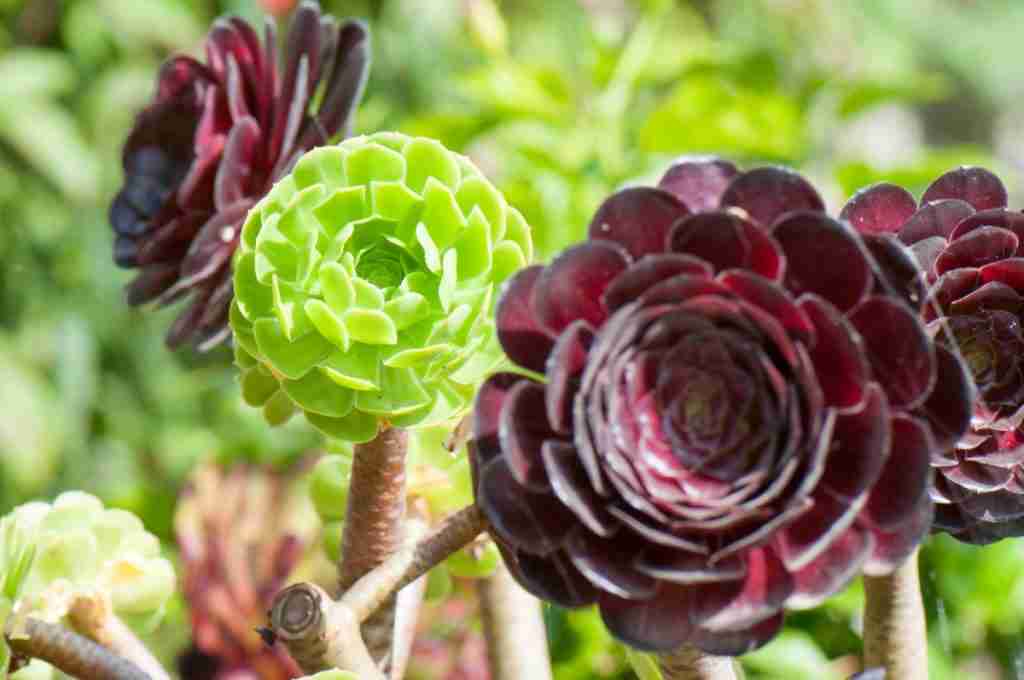
Like all other plants, Aeoniums have special requirements and needs when raising. Aeoniums are special, though, in that when flowering, they are unlike most others. Many plants thrive year after year after they produce flowers. This is not the case for aeoniums.
Once Aeoniums have bloomed, they will not provide any further growth or life in the parent plant. After the flowering of an aeonium has been enjoyed, the plant should be pulled from your flower beds and discarded, as the main flowering plant will die.
There are 35 species of Aeoniums, and all are considered succulents. Initially found in the Canary Islands and in the Middle East, people have long enjoyed their beauty as a plant. Even so, due to their wilting and death after flowering, they can only be enjoyed for so long.
Let’s take a look at the life of an aeonium and what to do with them after flowering.
If you are interested in exploring how to make an Aeonium branch out, I wrote a whole article sharing the 5 things to know.
What To Do With Aeoniums After Flowering
First, we need to realize that just because an aeonium plant dies after flowering does not mean you cannot enjoy the plant for many years before that happens.
Here is a breakdown of the life of an aeonium and what to do after it produces flowers.
1- Life Expectancy
An aeonium plant will give its owner years of life and brighten any flower bed. The life expectancy of any aeonium is anywhere from 3 to 10 years. This is also the timeframe it takes one plant to flower.
Dying after flowering is true for all monocarpic plants like the aeonium. Non-Monocarpic plants can be kept alive for years since they do not die after flowering.
The table below shows how different flowering plant species have many different lifespans.
| Arabidopsis Species Life Expectancy | Aeonium Life Expectancy | Peonies Flowering Plants Life Expectancy |
| 1 Month | 3-10 Years | Up to 100 Years |
As you can see, flowering plants have a large diversity when it comes to lifespan. Succulents such as the aeonium certainly developed differently than the flowering plant types listed.
2- Saving Some of the Aeonium Plant
Sometimes, an aeonium will have runners extending from the main plant. Although we say to discard the entire plant, these runners may be saved as separate plants until they bloom themselves.
When removing an aeonium after blooming, make sure to save anything that looks as if it has become a separate plant as a cutting.
There has been some success in keeping the entire plants alive by snipping off the flower heads as they begin to grow initially. This tricks the plant into thinking it has not flowered and continues to grow for a time.
3- Compost the Dead Plant
You can do this after the aeonium plant flowers and dies to compost the dead plant for fertilizer and use it in another flowering bed.
If you do this with all of your plants, you can build quite a compost pile to feed your other plants.
How Long Does it Take for Aeonium Cuttings to Root?
It takes about 3 to 4 weeks for aeonium cuttings to root. If you want to see your Aeonium to root, set it aside and keep it in a dry place away from direct sunlight. After about two weeks, you will notice roots forming from the bottom of the stem.
Rooting a New Aeonium
To keep from losing your aeoniums after flowering, it is important to propagate new plantings through cutting, as discussed above. This can take up to about three weeks to get a new plant established after cutting.
After you have some healthy cuttings from the parent plant, take the following steps.
- Place the cutting in a place to keep moisture away from it.
- Wait about two weeks for roots to begin to form from the cutting.
- Once roots take shape, you can plant your new aeonium in prepared soil.
By taking these steps, you can propagate your aeoniums to ensure you have plenty in case of flowering.

How To Grow Healthy Aeoniums?
Before your aeonium decides to flower, you will have many years of colorful plants to beautify your garden. With so many types and colors to choose from, aeoniums can be pleasant visuals to break up the monotony of plantings in your garden.
Although not difficult to grow, there are certain things to consider when planting aeoniums. Below are some necessities to address with aeoniums in your flowering beds.
1- Be Mindful of Sunburn
Aeoniums do like partial sun to full sun, but keep in mind that they are susceptible to sunburning. Once the leaves have been scorched by the sun, they will be damaged and will be damaged until new growth takes the place of the burnt leaves.
If you live in an area with extreme sun, you may want to think of moving them into the partial shade for a respite front for direct sunlight.
2- Aeoniums Can Become Stressed
Once an aeonium is stressed, it can lose leaves and enter a dormant state to protect itself. Once this happens, care must be taken to get the plant back to growing. Here are a few causes of stress to your aeoniums.
- Extreme heat, such as from a heatwave, can cause your aeonium to become stressed.
- Underwatering is probably one of the most common issues causing your aeonium to shut down. If you suspect this is the case, increase your watering frequency to see if the plant returns.
- Garden pests can be hard to detect until it is too late. Be mindful of your aeoniums, as pests feed on them like any other plant. If you suspect you may have pests causing stress, you will need to spray to kill them off.
- One way to tell if you have pests eating your plants is to watch for ants. Ants do not usually harm your plant but signify that smaller plant-eaters are nearby and attract the ants.
- Be mindful of soil that is too wet. Aeoniums prefer well-drained soil. If you have planted yours in soil that stays wet, it may cause stress to your plants.
By looking for signs of stress in your aeoniums and taking into account the above stressors, you will be able to take better care of and create a healthier life for them.
3- Proper Feeding of Aeoniums
Most aeoniums that are planted directly into the ground do not need much fertilizer. Usually, a good mulch added once a year is enough to keep them fed.
For those in planters, however, more fertilizer is suggested. Use a light worm compost added to the plant in fall and spring to keep them fed and healthy.
Best Climate for Growing Healthy Aeoniums
Since aeoniums are originally from the Mediterranean area, it makes sense that this is the climate they prefer. In the U.S., that means climate zones 9 and 10 are hardy plants. This does not mean they will not grow in more extreme climates.
They will need more care to protect them from too harsh environments such as extreme moist heat or freezing temperatures. If you live in zones 9 and 10, you will find that aeoniums thrive in this environment with little help.
What to read next:
- 5 Succulent Christmas Ornament Ideas For Diy Enthusiasts!
- How Often Should You Be Watering Your Terrarium? This Often!
- Can All Succulents Survive Winter? Here’s What I Think
Wrapping Up
Aeoniums are vibrant succulents that improve the look of any flowering garden. They can be reasonably easy to take care of with a little effort and keep them from stresses they are susceptible to. You can enjoy your aeoniums for years until the parent plant eventually flowers, at which time the main plant will die.
By making sure you propagate your plant by cutting runners and creating new root systems for new plantings, you will be able to continue to produce aeoniums for years to come.

